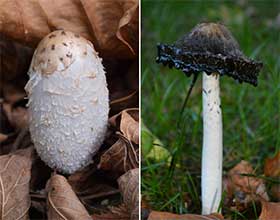 October is a great month for mushrooms. The cooler temperatures and moist soils promote mushroom emergence, and more than 125 species have been observed in Greene and Montgomery Counties. Some of those mushroom varieties can be hard to identify. But one that is quite common and recognizable is the shaggy mane, Coprinus comatus, also known as the lawyer’s wig.
October is a great month for mushrooms. The cooler temperatures and moist soils promote mushroom emergence, and more than 125 species have been observed in Greene and Montgomery Counties. Some of those mushroom varieties can be hard to identify. But one that is quite common and recognizable is the shaggy mane, Coprinus comatus, also known as the lawyer’s wig.
Shaggy manes are saprobes—they grow on dead or decaying organic matter, thereby helping to recycle those materials back to the ecosystem. (For a good glossary of fungal terminology, check out http://www.mushroomexpert.com/glossary.html.) Shaggy manes can be found in lawns, by roadsides, or among leaf litter in the woods. Often they appear in clusters, sometimes in lines or as “fairy rings.”
Shaggy manes are the most common local representative of the group of mushrooms known as “inky caps.” Young, freshly emerged shaggy manes form tight, white cones up to 3 or more inches tall atop white stalks. As the cone matures, scales form on the surface, contributing the shaggy, “wig-like” appearance. But, as described below, the appearance changes even more as the mushroom ages.
Mushrooms serve as the reproductive organs of fungi. Shaggy manes, like other mushrooms, primarily exist as strands of fungal cells—mycelia—that may stretch for long distances on or under the soil surface. When it’s time to reproduce—that is, to generate spores that can disperse to grow new fungi—the fungus constructs an above-ground structure that we call a mushroom. In mushrooms with distinct caps, the spores are produced on the underside of the cap.
For shaggy manes, the problem is that the cap is such a closed, tight structure—like an umbrella that has been furled up tight—that there is no convenient way for the spores to escape. And so, the mushroom employs a trick: as the tight, whitish cone ages, it opens and browns and appears to “melt” from the edges, dripping off as a dark black liquid. Technically, that melting is called deliquescence, and it results from enzymes within the cap that digest the cap itself. The spores are released as the cap opens or they drop off with the inky droplets. Other mushrooms also disintegrate after spore release—by that point, they are no longer needed—but not usually in such dramatically liquid form.
As young, white caps, shaggy mane mushrooms are an appreciated edible mushroom. (Note: do not consume wild mushrooms without first consulting an expert.) They are cultivated for human consumption in China and other Asian countries, though not so much in the U.S., and they sometimes are called chicken leg mushrooms. But people who harvest them for eating need to process them quickly. In China, the young cultivated mushrooms are quickly dried to preserve them. Otherwise, the liquefaction process begins within hours of harvest and turns the firm, edible cap into a slimy mess.
There’s another potential problem with eating shaggy manes. That is, a similar-looking mushroom, the common inky-cap (Corpinopsis atramentaria, which until recently was included with shaggy manes in the genus Coprinus), contains a chemical called coprine. Coprine interferes with humans’ metabolism of acetaldehyde, a chemical produced from ingested ethanol. Acetaldehyde is responsible for hangover symptoms and is toxic as it accumulates. So, common inky caps should not be consumed within about three days before or after drinking alcohol. This is not a problem with shaggy manes, which lack coprine, but good identification is important.
That being said, the black liquid from the “melted” mushroom—of either species—really does function as ink. It is easy to produce (just put some shaggy mane mushrooms in a jar for a while and let them liquefy; then strain the liquid through fine mesh), and it lasts for months. Indeed, numerous artists attest to the high quality of the ink. The only problem is that it smells a bit of decomposed mushrooms; but that’s just a minor inconvenience!
Autumn is always a fine time for wandering the woods and fields. This year, keep an eye out for clusters of tight, white, cone-shaped mushrooms. With proper skill, you could consider eating them. But even easier, amaze your friends by melting some mushrooms and filling a few vials of ink. What a great holiday gift! And if you have a lot of ink—well, Dr. Seuss has the answer, I think (if I remember Green Eggs and Ham correctly).
Article and photo contributed by Dr. David L. Goldstein, Emeritus Professor, Department of Biological Sciences, Wright State University.
